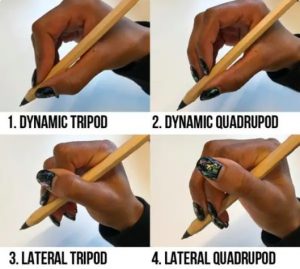6 Essential Tips for Improving Your Handwriting
. Posted in Journaling, Parent-Child Advice, Writing - 0 Comments
Handwriting is something that many people let fall by the wayside in the digital age, but there is true artistic value and design in something as creative and intricate as handwriting. Even if you aren’t interested in this aspect of handwriting, it’s still of general use to make your writing legible to other people. If even you find it difficult to decipher your own handwriting, it’s time to make a change. Here’s how to do it.
1. Set your goals. Why do you want to improve your handwriting? You need to know exactly what you hope to achieve so you know what to focus on. Maybe there are a few letters you’ve never really been sure of, or maybe you want to write more fluently and efficiently so your hand doesn’t cramp up after five minutes. It could be a purely aesthetic thing for you, or perhaps you want a new and creative challenge. Still others may want to improve their penmanship because it aids their sense of authority at work if they’re in a management position. Whatever the reason is, when you understand exactly what it is, you can more accurately and determinedly home in on your goal.
2. Choose your weapon. The pen truly can be mightier than the sword, but only if you find one you really like. Pick up a bunch of different kinds of writing utensils and try them out to see what feels best. Looking for smooth gel? Pilot G2 has you covered. Feeling more velvety matte? Micron might be for you. These two are my personal favorites, but there are plenty of other popular choices out there, including Muji, Stabilo, Staedtler, Unipin, or Sakura. Bonus tip: if you’re left-handed, try these quick drying Uni-Ball pens to cut down on the smudging.
3. Get a grip. You may not have even thought about the way you grip your pen before, but it actually has a significant effect on your handwriting. Your grip should be light yet supportive, and there should be no undue tension in your hand position. It doesn’t really matter which fingers you use to hold the pen, as long as it feels comfortable and balanced, but it’s best for the top of the pen to rest on (or just in front of) the base knuckle of your index finger. Here are some examples of different grips:

4. Align your body and posture. Sit up straight yet relaxed, with your non-writing fingers gently curled under your hand, and your hand position resting lightly on the table. Once you have a comfortable writing position, be careful of altering your alignment. When it becomes awkward to move your hand position down the page to write the next line, try moving the paper up instead of your hand down. Additionally, as strange as it sounds, you should not be using your wrist and fingers to write–rather, your fingers should hold the pen in place and act as a guide, and all the movement should come from your shoulder. In other words, your shoulder and forearm move as you write, but your wrist and fingers don’t. This helps you write in a more fluid, efficient style. It takes practice and feels weird at first, but your shoulder muscles don’t get tired as quickly as those in your wrist and fingers.
5. Utilize resources. The Internet makes learning most anything easier, and handwriting is no exception. YouTube has countless instructional videos–this one is good for beginners, and this one has some great condensed tips. If you’re looking for inspiration, check out a mesmerizing calligraphy video or two. The Reddit handwriting forum can be a great resource and a place to ask questions or request help from others. You could also purchase a handwriting practice book online, or check out this post with exercises you can replicate on your own.
6. Practice as much as you can. Take every opportunity to write longhand instead of on a keyboard. If you’re a writer or you just need to write a report or proposal, consider doing your first draft using pen and paper. You could also write out to-do lists and shopping lists or start keeping a journal. If you’re stuck in a boring meeting, presentation, or lecture, fill the time with handwriting practice. If you make sure to practice your handwriting for a few minutes each day, you should start to see improvements quicker than you would expect.
Allison Green
Boston Tutoring Services
